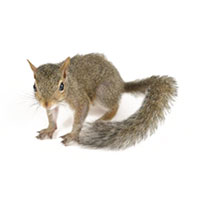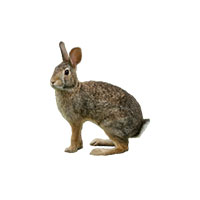Fast Facts![]()
| Color | Typically dark brown in color, muskrats have dense coats that are mostly waterproof and covered in coarse hairs. |
| Size | Adults weigh between two to five pounds and are 16 -25″ long. Muskrat tracks are small with long, finger-like toes. The rear print is 2-3″ long and may look like a smaller version of a raccoon track. Although they have five toes, often the front print appears four-toed because the inner toe is extremely small and barely shows in the track. |
| Appearance | Muskrats are often confused with the beaver, but they are much smaller with silky brown fur and have a long, thin tail instead of a wide, flat tail like a beaver. Other distinguishing features include small eyes and ears, short front legs with claws for digging, and longer hind legs with partially webbed feet that help the animal swim. |
Muskrat Diet
Muskrats primarily eat aquatic vegetation like bulrushes and cattails, though they will also eat fruits and vegetables. A small part of their diet is shellfish, snails, fish, and frogs, and these are generally consumed when plant foods are scarce.
Muskrat Habitat
Muskrats prefer living in areas with consistent sources of shallow water, including ponds, swamps, slow-moving streams, marshes, and other wetlands. They burrow into the banks of ponds or streams, constructing dens that typically have at least one underwater entrance and are made of aquatic plants and mud.
Muskrat Life Cycle
After a 30-day gestation period, females give birth to two or three litters per year with each litter averaging four to eight pups. The size of the litter varies with the seasons; larger litters born in spring and summer and smaller litters born in winter. Newborn muskrats are weaned for about a year before they become independent.
Muskrat Damage & Signs of an Infestation
The majority of muskrat damage is done to the ecosystems in which they live because their feeding habits cause deterioration of available food sources for other species. Additionally, the animal’s preference for building dens on the banks of waterways can affect existing dams. Homeowners that plant gardens near muskrat habitats can experience loss of crops.
Tracks
The footprints appear with four toes in the front and five in the back with visible claws marks. There is often a visible tail mark in between the footprints. Muskrat tracks can be found in mud or sand along shorelines.
Droppings
You may notice muskrat droppings on dry, elevated surfaces such as stumps, logs, rocks, feeding sites, or floating in the water. Droppings are dark green, brown, or almost black. They are slightly curved, cylindrical, and about 1/2″ long and 3/8″ in diameter.
Feeding Platforms
Feed sites are elevated, flat pads of mud, and compacted vegetation. Feeding huts look like small lodges about one foot above the water level and are hollow inside.
Lodges
Muskrat dens are made with piles of mud and aquatic vegetation, up to eight feet in width and five feet tall.
Waterway Issues
Waterways will show the presence of muskrats with leaking ponds or dams or collapsed banks due to extensive burrowing.
Muskrat Prevention & Control
Muskrat Prevention
Habitat modifications can be implemented to discourage muskrats from living in certain areas. Managing slopes and water levels, trimming overgrown vegetation, and installing barriers help prevent muskrats from burrowing into pond embankments. Fencing around gardens and picking up fallen fruit will also discourage muskrats from using your yard to obtain food.
Muskrat Control
Much of wildlife control is knowing and understanding the habitat and behavior of the animal. For muskrats, Batzner uses live trapping with fresh vegetables, carrots, or apples.
If you’re having problems with muskrats around your home or business, contact a pest control professional for expert removal services.
Need help with Muskrats?
We'll call you! Leave your information below.





